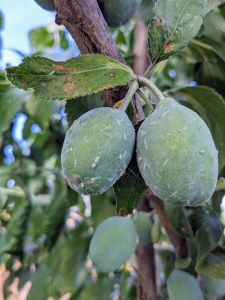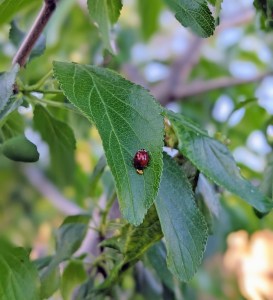COLUMN | Milkweed + Honey: A tale of two plums
Published 8:00 am Wednesday, June 25, 2025
Fruit trees are a lesson in patience.
Several years ago, the bare-root Italian plums I planted took their sweet time growing from featureless sticks to recognizable trees.
For their first few seasons, I faithfully snipped off the sparse baby plums. This is recommended to help the trees establish a strong root structure before spending copious energy producing fruit. So I denied myself their bounty. The leaves got shothole disease. One trunk got thwacked with a lawnmower. But the trees kept growing, ever so slowly.
(Well, it was slow until my ducks began emitting excessive fertilizer around them last year. Now the trees are making up for lost time and shooting far higher than they should for being on dwarf rootstocks. Classic nitrogen problems! I’m gonna need a bigger ladder.)
 Finally, last spring, I decided the time had come. I would let the trees produce. And produce they did! Those branches were doggone laden, even after I removed some flowers from each cluster to reduce branch weight and enhance fruit quality. Like so many farmers of old, I surveyed my young crop with glee and counted my harvest before it hatched — and then the insects humbled me.
Finally, last spring, I decided the time had come. I would let the trees produce. And produce they did! Those branches were doggone laden, even after I removed some flowers from each cluster to reduce branch weight and enhance fruit quality. Like so many farmers of old, I surveyed my young crop with glee and counted my harvest before it hatched — and then the insects humbled me.

My poor young Italian plums looking ravaged by aphid frass.
You wouldn’t believe the number of aphids that suddenly appeared. You know in “The Two Towers” when Grima Wormtongue is like, “Saruman, my guy, we CANNOT defeat the defenses of Helm’s Deep. No one can! It would take a number beyond reckoning to storm the keep!” And Saruman, smug, is like, “Lol chill, I actually have a number beyond reckoning right here.” And then the camera pans out to see formations of tens of thousands of Uruk-hai stretching to the horizon, and Wormtongue just looks all Surprised Pikachu? That’s how I felt looking at the invasion of plum aphids. Surprised Pikachu. Sickened Pikachu. Perhaps, I admit, even Panicked Pikachu.
My precious green leaves were white and pale from the armies of tiny sap-suckers. Much of the new growth was browning and curling. Lines of aphids and the ants farming them marched up and down the trunk. (Ants will protect, herd, and “milk” aphids for the nutritious honeydew they excrete.) The still-green plums were starting to look scratched and scarred from so much traffic, honeydew, and suckering. After all my waiting, would my trees survive? Would I eat of the fruit? I despaired.
But even now, there was hope left. You know in “The Return of the King” when the eagles are coming and Pippin yells, “The eagles are coming”? That’s how I felt watching lady beetles fly in. That’s how I felt finding clumps of their tiny golden eggs on the underside of leaves. That’s how I felt watching their larvae munch on aphids.
These predatory beetles, commonly called ladybugs, showed up en masse to chow down on aphid flesh and, unknowingly, ally in my war. The battle wasn’t over, but these reinforcements turned the tide. In August and September, I picked endless plums, sun-warmed and safe.
OLD ENEMIES
Something like 4,000 types of aphids exist worldwide, though only a couple of hundred bother plants and people. Two of those wee, soft-bodied species especially love plum trees: the plum leaf-curling aphid and the mealy plum aphid. They’re both shades of green. The leaf curlers hatch in early spring when the tree flowers, and the mealy guys emerge mid-spring. After feasting on foliage and sometimes fruit, some develop wings and move elsewhere for the rest of summer, until returning before winter to lay eggs on the tree. I think I had both types on my tree. Just my luck!

An Asian lady beetle lays eggs on a plum tree leaf. (Staff photo: Kate Schell)
Lady beetles, fortunately, love to snack on little guys like aphids and mites. Of the 6,000 species of ladybugs, you’re most likely to see a handful around the Portland area: converse lady beetle, transverse lady beetle, and multicolored Asian lady beetle. The first is a North American species. Converse lady beetles have red wings with 12 black spots. They overwinter at higher elevations and then return to the valleys to lay eggs. Originally hailing from India, transverse ladybugs love stone fruit aphids, emerge earlier than many other species, and have elongated black blotches on their red or orange wings. The last type is an Eurasian expat that has long been imported to control aphids in orchards but has become rather invasive. It is more aggressive than other ladybugs, varies from red to orange or yellow (with or without spots), has a mostly white head that sets it apart from most native species, and is the type most likely to overwinter in your home. All these beetles lay clusters of yellow or gold eggs, which hatch into funny, alligator-shaped larvae — these are your strongest soldiers against hordes of aphids.
Of course, having some aphids around is good for the life of your garden. The aphids bring in predators and friends (such as the aforementioned ants), and bigger insects and birds eat those smaller predators, and your yard is teeming with life, and everyone is full and happy. Plants are food and habitat for small annoying bugs as much as they are food or décor for us.
Thus, the goal never should be total decimation, but rather balance. After all, if you take out one curve in the circle of life and it becomes, uh, a polygon of death? I was never good at math, but you get the idea. Making peace with the presence of mild pests is essential for the health of all creatures, great and small. Still, a true overpopulation of aphids can affect the quantity and quality of fruit you harvest. Especially in the early spring, when aphids rapidly multiply before many natural predators wake up for the season. In rare cases, the tree’s health could be affected if it is already dealing with other significant issues.
So there are several steps you can take to reduce aphid populations:
- Spray the affected plant with water. Use the strongest setting on your hose, do it every evening for a week or so, and target the busiest spots. I was very skeptical of this method after trying it once or twice with little visible change, but my husband sprayed the trees persistently, and it does, in fact, have a cumulative effect.
- Manually pick off. If you notice a small population of aphids just getting established on a plant, you can wipe the undersides of affected leaves, snip off infested branches, or crush larvae with a gleeful will.
- Control ants. These industrious farmers will do their best to ward off predators of their favored livestock. They’ll get up off their rocking chairs and grab their tiny rifles. Wrapping a sticky band around the base of the trunk can block ants altogether.
- Encourage predators. You want your garden to welcome lady beetles, parasitic wasps, earwigs, soldier beetles, lacewings, and other beneficial insects who chow down on tinier pests. The key to this? Say it with me: Biodiversity! That’s right, we’re back to my favorite topic. Growing a diverse selection of native plants creates habitat for many friendly bugs. If space permits, try to include flowering plants, grasses, and larger shrubs or trees. Make sure something is blooming from early spring to late fall. Include an array of flower shapes: some bugs like big umbels to land on, some prefer globes, some spikes or solitary blooms. In my yard, yarrow and fireweed especially bring in a host of species. Lastly, avoid pesticides! Sure, they control foes, but they also kill off friends.
- Import predators? If your yard isn’t yet an oasis that attracts and retains beneficial insects, you can try buying them.
BUYING BUGS
Confession: I knew from my Master Gardener training that releasing captured lady beetles (and other predators like lacewings or praying mantis) is inconclusive at best but probably worthless most of the time. Ladybugs are things with wings, and thus they fly away. Also, there is controversy about the harvesting practices. Some companies capture North American lady beetles in the wild, potentially harming their populations. Others import Asian lady beetles, which have been overused for years and often outcompete native species. Taking beetles from one region and releasing them in another can disrupt biodiversity and spread diseases. Science doesn’t recommend buying beetles!
Yet I am but a human, as prone to experimentation and hubris as any. This spring, I noticed that all the beetles already working on the repeat invasion of aphids seemed to be the multicolored Asian variety. I worried that they’d pushed out the other species I noted last year during The Great Plum War. One day, I saw some North American lady beetles for sale at my local garden shop. You know in “Fellowship of the Ring” when Bilbo leaves The Shire and his ring to Frodo, but he gazes at the glinting gold and mutters, “After all, why not? Why shouldn’t I keep it?” That’s what I was like in the checkout line, grabbing some forbidden beetles, with no wise wizard around to stop me.
We have to make our own mistakes sometimes. This one at least only costs $12.
I followed best practices when releasing my convergent lady beetles: I refrigerated them for at least an hour to induce light dormancy. I waited until evening (so they’d likely find a safe spot and hunker down for the night). I freed them upon several types of leaves providing food (the abundant aphids) and water (droplets I spritzed on right beforehand). I tried this in spring, when aphid populations were high enough to feed an influx of predators.
The big moment came. I cut a corner off the sealed net and watched one after another slowly emerge. Quickly it became clear the small corner hole was causing a slothful stamped and traffic jam. So I cut another corner off, then carefully sliced a big flap for them to walk out of. All the while, hundreds of little lady beetle legs were flopping through the net as they tried to navigate to freedom.
They did not, as feared, fly away immediately. They moseyed. They sipped from droplets and supped on aphids. A few mated languorously. They all took in their new surroundings: The plum leaves, the kale stems, the yarrow umbels. They liked it!
The next morning, I saw plenty of convergent beetles still around. The morning after that, far fewer. Several days later, I noticed a boom of larvae — so many fuzzy alligators feasting upon so many aphids. Were those larvae from eggs laid by the released beetles before they moved on? The timing was right, but it’s hard to say. As of writing this, it’s too soon to see whether those larvae will develop into a noticeable increase in convergent lady beetles in my garden for the summer.
I think the impulse to Try Something New Even If It’s Probably A Bad Idea has passed, and I won’t buy any insects again. I’ll keep following actual research, expanding the biodiversity in my garden and . . .
You know in “The Hobbit” when Bilbo is like, I don’t want to go on an adventure or rob a dragon or write a book, I just want to eat cheese five times a day and take a nap? That’s just like me right now. I bid you all a very fond farewell. Goodbye!






